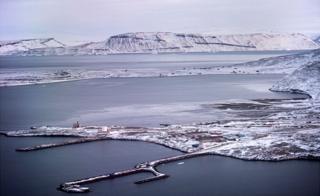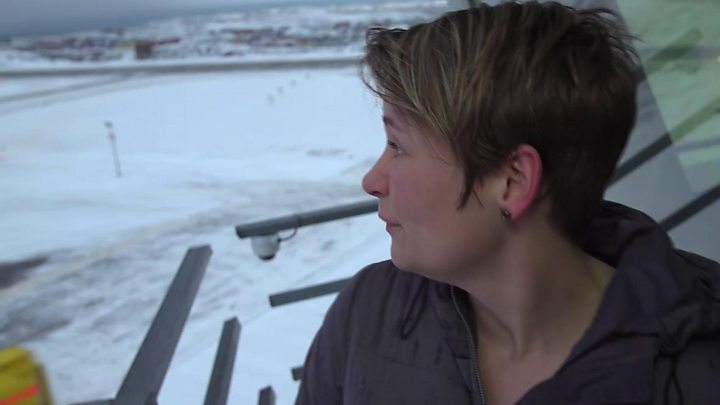Greenland judged security risk amid Arctic tension
Denmark has for the first time put mineral-rich Greenland top of its national security agenda, ahead of terrorism and cybercrime.
The Defence Intelligence Service (FE) linked its change in priorities to US interest in Greenland, expressed in President Donald Trump’s desire to buy the vast Arctic territory.
Greenland is part of Denmark, but has significant autonomy, including freedom to sign major business deals.
China has mining deals with Greenland.
The FE’s head Lars Findsen said Greenland was now a top security issue for Denmark because a “power game is unfolding” between the US and other global powers in the Arctic.
In August the Danish government dismissed as “absurd” President Trump’s suggestion of a US-Denmark land deal over Greenland.
Mr Trump then cancelled a state visit to Denmark and called Danish Prime Minister Mette Frederiksen “nasty”.
The US interest in Greenland goes back decades. The US has a key Cold War-era air base at Thule, used for surveillance of space using a massive radar. It is the US military’s northernmost base, there to provide early warning of a missile attack on North America.
Why the new focus on Greenland?
Greenland’s strategic importance has grown amid increased Arctic shipping and international competition for rare minerals. Arctic waters are becoming more navigable because of melting ice, linked to global warming.
The vast island is strategically located between North America and Europe, easing deliveries to many markets.
In a statement to the BBC, the FE’s Lars Findsen said: “We have decided to start this year’s Intelligence Risk Assessment with a chapter on the Arctic, as the interests of the great powers in the Arctic have direct impact on and growing significance for the Kingdom of Denmark.
“Despite the Arctic nations’ shared ambition to keep the region free of security policy disagreements, the military focus on the Arctic is growing. A power game is unfolding between great powers Russia, the United States and China that deepens tensions in the region.”
Russia has stepped up its economic and military activities in the Arctic. There are competing territorial claims at the UN from Denmark, Russia, the US and Canada in the North Pole region, where energy and mineral resources are becoming more accessible.
Kasper Wester, a defence journalist with Danish news website OLFI, says Denmark’s military routinely patrols Greenland’s airspace and waters.
However, in August Denmark sent a large support ship to Greenlandic waters for the first time. The Absalon, and sister ship Esbern Snare, are the biggest Danish naval vessels.
What about Greenland’s precious minerals?
Mining is expanding because Greenland’s vast ice sheet has been retreating significantly in recent years.
A joint venture between Greenland Minerals Ltd and Shenghe Resources Holding will enable China to import rare earth minerals containing radioactive uranium and thorium.
The rare earths surveyed in the Kvanefjeld project, in southern Greenland, are estimated at 270,000 tonnes of uranium and 11m tonnes of rare earth oxide, Australia-based Greenland Minerals Ltd says.
The China National Nuclear Corporation (CNNC) is participating in the project.
The business website export.gov, run by the US government, says “mining industry experts anticipate the retreating ice will make the island’s rich stores of raw materials more easily accessible”.
Elsewhere in Greenland there are valuable deposits of ruby and sapphires, as well as gold, platinum, zinc, lead and molybdenum.
London-based Bluejay Mining is developing a mine to extract ilmenite at Dundas near Thule Air Base. Ilmenite is the main ore for producing titanium. Danish and Greenlandic firms have bought stakes in the ilmenite mine.
Bluejay says it is developing two other mines in Greenland: a huge nickel-copper-platinum project at Disko-Nuussuaq, and the Kangerluarsuk zinc-lead-silver project. More than half of Bluejay’s workforce is Greenlandic or Danish.
Read more on related topics:
What are Danish-Greenland relations like now?
Greenland’s population is about 56,000 and for decades the territory has been economically dependent on Denmark.
The Self Rule Act of 2009 granted Greenland far-reaching autonomy, though Denmark retains control over foreign affairs, defence, security and immigration.
Fisheries account for more than 90% of Greenland’s exports, most of which go to Denmark, and prawn is the main species caught.
Denmark is helping Greenland to build three big international airports, one of them in the capital Nuuk. A Chinese bid for the airport project was rejected.
The government in Copenhagen gives Greenland an annual block grant of 3.9bn Danish kroner (£445m; $574m).
Speaking to the BBC, journalist Kasper Wester said “for Greenland’s people there is huge potential income in exporting minerals, and the whole independence discussion relates to that”.
Some Greenlandic politicians were pushing for independence, he said, but most of them “know they would be much worse off without the Danish subsidy”.
But he said there was still discussion about whether Danes were too colonial in their approach to Greenland.
“Danish politicians are very cautious about what’s going on. Not many will say it’s a good idea to do too much business with the Chinese,” he added.
Source: Read Full Article




